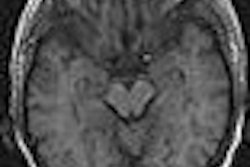The detrimental effects of obesity on the heart include increased blood pressure and higher levels of blood cholesterol and triglycerides. Outside the circulatory system, excessive weight can induce diabetes and cause degenerative joint diseases. The presence of these nonheart-related conditions can complicate cardiovascular tests on obese patients.
Two recent studies looked at the independent effects of obesity on cardiac investigations. First, a group from the U.K. evaluated the association between uncomplicated obesity and decreased aortic elastic function. In a second study, researchers matched obesity trends with changing diagnostic principles in cardiac MR (CMR).
Aortic mechanical function
"Obesity ... has been shown to increase the risk of cardiovascular disease and been implicated in coronary artery disease and heart failure," wrote Dr. Monique Robinson and colleagues in a poster presentation at the 2005 Society for Cardiovascular Magnetic Resonance (SCMR) meeting in San Francisco. However, these patients invariably have concomitant insulin resistance, diabetes, or hypertension, they explained.
Robinson's group is from the University of Oxford Centre for Clinical Magnetic Resonance Research and the University Laboratory of Physiology in Oxford, U.K.
"We postulated that the adipokine leptin, produced in excess in obesity, would be associated with cardiovascular changes," they stated.
For this study, 27 asymptomatic normotensive obese subjects were enrolled, as were 12 sex-matched control subjects (BMI of 23 kg/m2). The mean body mass index (BMI) for the participants was 33 kg/m2. They were scanned in a 1.5-tesla system (Magnetom Sonata, Siemens Medical Solutions, Malvern, PA) with cine images acquired at the ascending aorta, proximal descending aorta, and distal descending aorta.
Aortic compliance, distensibility, elastic modulus, and stiffness index were calculated. Other measurements were done for blood pressure, fasting lipids, glucose, insulin, leptin, and insulin resistance.
The results showed that leptin was significantly higher in the obese group (8.9 ± 0.6 ng/ml) than in the control group (4.7 ± 0.6 ng/ml). The mean aortic compliance was significant lower in the obese subjects (0.9 ± 0.1 mm2/mmHg) than in the normal subjects (1.5 ± 0.2 mm2/mmHg). Aortic compliance correlated negatively with BMI, fast mass, and leptin.
The distensibility was also markedly lower in obese patients (3.3 ± 0.01 mmHg -1 x 10-3) versus the control (5.6 ± 0.01 mmHg -1 x 10-3). Distensibility correlated negatively with BMI, fat mass, and leptin.
Lower aortic compliance and distensibility indicated "reduced aortic buffering capacity and elasticity." A higher stiffness index in the obese group reflected deranged intrinsic vessel elasticity, the group said, although the elastic modulus did not differ. However, fat mass and BMI were highly predictive of elastic modulus.
Using a multiple linear regression to determine the main predictors in obesity, the authors found "fat mass as the strongest predictor of aortic compliance; leptin and BMI were also predictive." Distensibility was predicted by fat mass, BMI, and leptin.
Aortic elastic function is markedly deranged in uncomplicated obesity, they concluded. "Fat mass is the strongest predictor of central arterial dysfunction, closely followed by leptin and BMI," they wrote.
Sizing up Americans
In a second study, Dr. Gurpreet Baweja and co-authors assessed the relationship between jugular venous pressure and obesity. Baweja is from the University of Arizona Sarver Heart Center in Tucson. One co-author, Dr. Raad Mohiaddin is from Royal Brompton Hospital in London.
"Patient factors such as anterioposterior (AP) diameter of the chest and BMI should be considered when assessing jugular venous pressure," the group wrote in their SCMR poster. "Determination of the central venous pressure from jugular venous pulsation depends on the notion that the distance from the sternal angle to the mid-right atrium (SA-RA) is a constant, measuring 5 cm."
However, this SA-RA measurement is based on historical estimates of body size that may be outdated, they added. According to obesity trend reports compiled by the Centers for Disease Control and Prevention's Behavioral Risk Factor Surveillance System, in 1992 about 13% of adults (average height of 5'4") in the country were 30 lbs or more overweight. A decade later, that number has climbed to over 20%.
"It is certainly possible, and even probable, that 5 cm may have been valid 50 years ago when patients were routinely smaller," they said.
For this study, they used CMR to measure the distance from the middle of the RA to the SA in a clinically representative patient population. Consecutive offline measurements were performed on all patients who came in for routine CMR during a two-month period.
The study population consisted of 58 patients (28 male, 30 female) with a mean age of 35 years. The mean height was 1.69 meters, and the mean weight was 75.1 kg with a mean BMI of 27.1 kg/m2. The mean AP diameter of the chest was 197.8 mm. The mean SA-RA distance was 6.8 + 1.8 cm in males and 5.8 + 1.5 cm in females. The mean AP diameter of RA was 51.5 mm.
"The SA-RA distance is larger than previously noted and correlated with body size and gender," the group concluded. "With the larger BMI currently noted today in industrialized nations, our data support using a more accurate SA-RA distance of 6 cm for females and 7 cm for males."
The results of both these studies are particularly important in light of new research indicating that obesity is associated with a poor outlook for patients with established cardiovascular disease. A Canadian group from Laval University Heart and Lung Institute in Quebec found that patients with a higher BMI had a 20% increase in the adjusted relative risk for myocardial infarction.
Their patient population consisted of 6,620 men and 2,182 women who were followed for a median of 4.5 years. During the time there were 1,034 deaths, of which 658 were due to cardiovascular disease. In addition, 1,018 subjects had a myocardial infarction, 364 had a stroke, and 297 had an event related to congestive heart failure (American Heart Journal, January 2005, Vol. 149:1, pp. 54-60).
By Shalmali Pal
AuntMinnie.com staff writer
February 14, 2005
Related Reading
Obesity gets in the way of good images, December 2, 2004
Obesity in women linked with brain tissue loss, November 23, 2004
Childhood adiposity predicts cardiac mass in adulthood, November 23, 2004
Copyright © 2005 AuntMinnie.com



.fFmgij6Hin.png?auto=compress%2Cformat&fit=crop&h=100&q=70&w=100)




.fFmgij6Hin.png?auto=compress%2Cformat&fit=crop&h=167&q=70&w=250)











